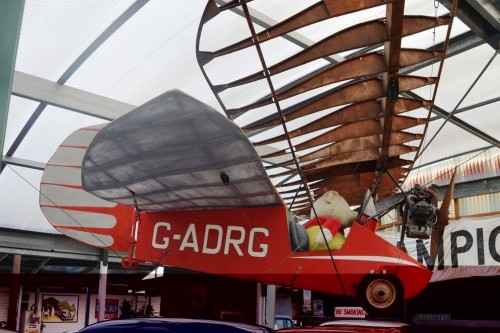
Click Here for Full Screen Image - Click Here to Download Image
 |  |  |  |  | |||||
 |  |
| Lot number | 125 |
|---|---|
| Hammer value | £800 |
| Description | Flying Flea Aircraft |
| Year | c.1939 |
| Colour | Red |
| Engine size | 425 cc |
In the early 1920s, Frenchman Henri Mignet had the idea of building a light aircraft of such simple design that any amateur constructor might do the same and fly it easily and safely from any suitable strip of ground; an airplane for the common man.
Henry Ford’s economy car was known in France as the "Pou de la Route" or "Louse of the Road", Mignet’s aeroplane was thus known as the "Pou du Ciel," or in the English translation, the "Flying Flea."
In 1933, Mignet publicly demonstrated the first flight and a year later published the plans and building instructions in his book 'Le Sport de l'Air'. In 1935, it was translated into English and serialised in 'Practical Mechanics' in the USA, prompting hundreds of people around the world to build their own Flying Fleas.
The definitive version was originally powered by an Aubier-Dunne 500cc two-stroke motorcycle engine. It had a wingspan of 19.5 feet, a length of 11.5 feet and a gross weight of just 204kg. It had a usable speed range of 25-62mph. In the UK in 1935 and 1936, many aerodynamic and engine developments took place, notably by Stephen Appleby, John Carden and LE Baynes.
Unfortunately the Flying Flea had a fundamental error in the wing arrangement whereby the airflow over the main wing affected that over the rear wing and in certain situations this resulted in an unrecoverable and often fatal dive into the ground. This was not apparent in early testing but only occurred later when the performance improved with more powerful engines. The UK aviation authorities eventually grounded the aircraft, but despite modifications to overcome the problems, the Flying Flea never lost its reputation of being a dangerous craft to fly and therefore never fulfilled Mignet’s dream of producing an aircraft for the common man.
G-ADRG comes with a letter from a previous owner explaining the history of the aircraft. It appears that this Flea’s front and rear wings were constructed in the late 1930s at the height of their popularity. As with many such Flying Flea projects, it ‘stalled’ at this point and the remainder of the aircraft, including the fuselage, wasn’t completed until 1974 as a display piece for the Skyfame Museum in Gloucester.
When the Museum closed in 1979, it was passed to the Cotswold Aircraft Restoration Group at Innsworth for use as a travelling exhibit at shows and fetes. After 10 years of good service it went on display near Stratford-on-Avon where it deteriorated rather badly.
It was then acquired by a gentleman living near Cheltenham who undertook a lot of restoration work, including recovering the fuselage, rudder and rear wing in ‘Diatex’ fabric and the fitting of an early Citroen flat-twin 425cc engine. The propeller is from a Tiger Moth which has been cut down and balanced, the original intention being to make the aircraft capable of ground running, which given the Flying Flea’s dubious flight record is probably as close to take-off as it is wise to get.
This lot will be available to view at Stondon Museum (SG16 6JN) on Friday 5th June. Although this vehicle will be offered for sale at Brightwells (HR6 0DE) it will need to be collected from Stondon.